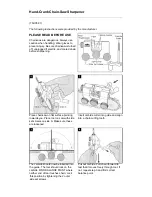
8
Accessories must be rated for at least the
speed recommended on the tool warning
label.
Wheels and other accessories running
over rated speed can fly apart and cause injury.
Hold tool by insulated gripping surfaces
when performing an operation where the
cutting tool may contact hidden wiring or
its own cord. Contact with a “live” wire
will make exposed metal parts of the tool
“live” and shock the operator.
If cutting
into existing walls or other blind areas where
electrical wiring may exist is unavoidable,
disconnect all fuses or circuit breakers feeding
this worksite.
Always disconnect the power cord from
the power source before making any
adjustments or attaching any accessories.
You may unexpectedly cause the tool to start,
leading to serious personal injury.
Be aware of the switch location, when
placing the tool down or picking the tool
up.
You may accidentally activate the switch.
Always hold the piece firmly in your hands
during the start-up.
The reaction torque of
the motor, as it accelerates to full speed, can
cause the shaft to twist.
Always wear safety goggles and dust
mask.
Use only in well ventilated area. Using
personal safety devices and working in a safe
environment reduces risk of injury.
After changing the bits or making any
adjustments, make sure the collet nut and
other adjustment devices are securely
tightened.
Loose adjustment device can un-
expectedly shift, causing loss of control; loose
rotating components will be violently thrown.
Do not reach in the area of the spinning
bit.
The proximity of the spinning bit to your
hand may not always be obvious.
Allow brushes to run at operating speed
for at least one minute before using wheel.
During this time no one is to stand in front
or inline with the brush.
Loose bristles or
wires will be discharged during run–in time.
Wire and bristle brushes must never be
operated at speeds higher than 15,000/
min. Direct the discharge of the spinning
wire brush away from you
. Small particles
and tiny wire fragments may discharge at high
velocity during the “cleaning” action with these
brushes and may become embedded in your
skin. Bristles or wires will be discharged from
brush at high speeds.
Wear protective gloves and face shield
with wire or bristle brushes. Apply wire or
bristle brushes lightly to the work as only
the tip of the wires/bristles do the work.
“Heavy” pressure on bristles will cause the
wires or bristles to become overstressed,
resulting in a whipping action and will cause
wire/bristles to be discharged.
Carefully handle both the tool and individual
grinding wheels to avoid chipping or crack-
ing. Install a new wheel if tool is dropped
while grinding. Do not use a wheel that may
be damaged.
Fragments from a wheel that
bursts during operation will fly away at great
velocity possibly striking you or bystanders.
Never use dull or damaged bits. Sharp bits
must be handled with care.
Damaged bits can
snap during use. Dull bits require more force to
push the tool, possibly causing the bit to break.
Use clamps to support work piece when-
ever practical. Never hold a small work
piece in one hand and tool in the other
while in use. Allow for sufficient space, at
least 6”, between your hand and spinning
bit.
Round material such as dowel rods, pipes
or tubing may have tendency to roll while being
cut, and may cause the bit to “bite” or jump
toward you. Clamping a small work piece
allows you to use both hands to control the tool.
Inspect your work piece before cutting.
When cutting irregularly shaped work-
pieces, plan your work so it will not slip
and pinch the bit and be torn from your
hand.
For example, if carving wood, make
sure there are no nails or foreign objects in the
work piece. Nails or foreign objects can cause
the bit to jump.
Never start the tool when bit is engaged in
the material
. The cutting edge may grab the
material causing loss of control of the cutter.
The direction of feed with the bit into the
material when carving, routing or cutting
is very important. Always feed the bit into
the material in the same direction as the
cutting edge is exiting from the material
(which is the same direction the chips
are thrown).
Feeding the tool in the wrong
direction, causes the cutting edge of the bit to
climb out of the work and pull the tool in the
direction of this feed.
SPECIFIC SAFETY INSTRUCTIONS FOR
THE VARIABLE SPEED ROTARY TOOL

































